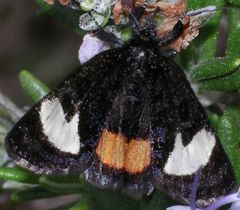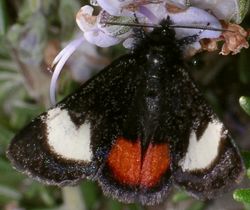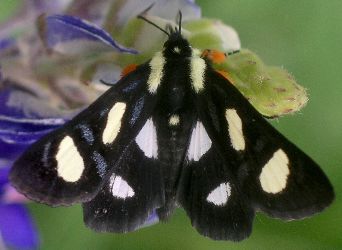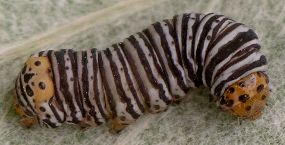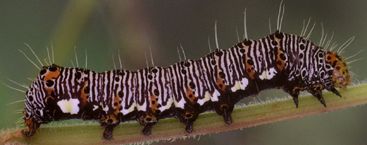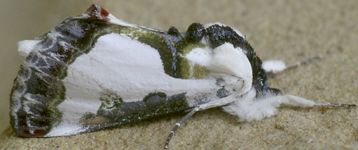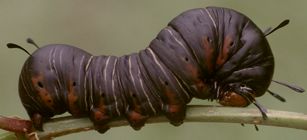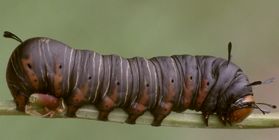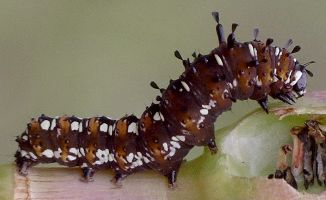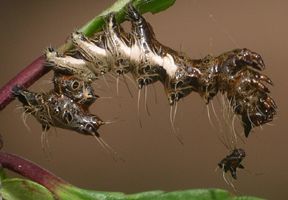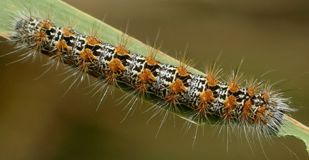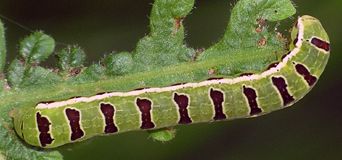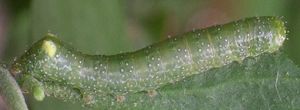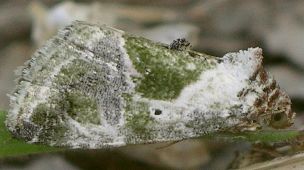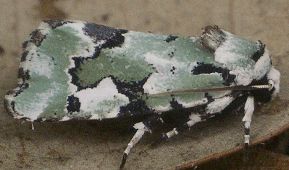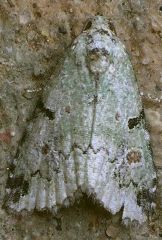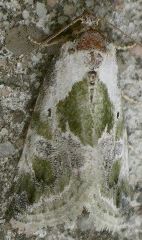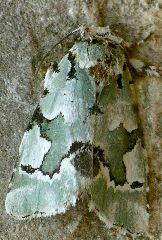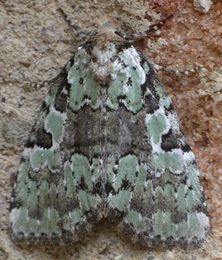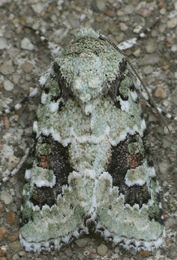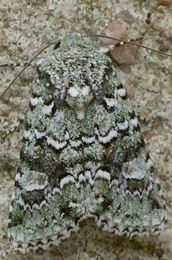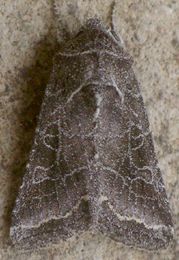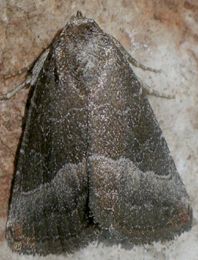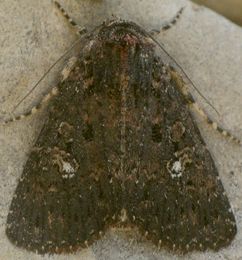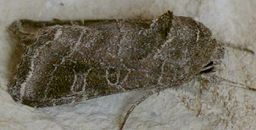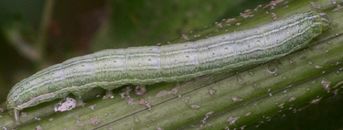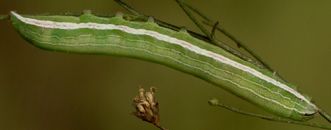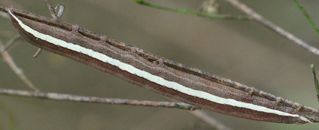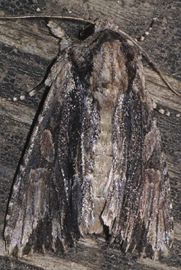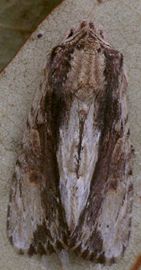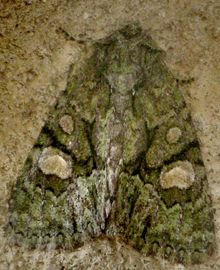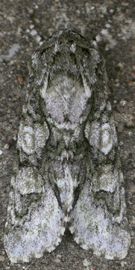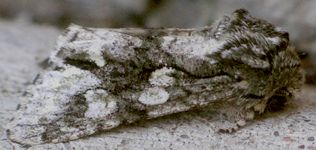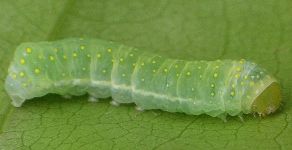
| Noctuidae ~ Owlet Moths |
page 1 ![]() page 2
page 2 ![]() page 3
page 3 ![]() page 4
page 4 ![]() page 5
page 5 ![]() page 6
page 6 ![]() page 7
page 7 ![]() page 8
page 8
|
There are two very charming moths that fly only in the spring. The Grapevine Epimenis (Psychomorpha epimenis) is usually seen in Feb. and nectars at early-blooming shrubs and trees. Large groups of these moths may be seen flying around grape vines, well before these have leafed out. They probably lay their eggs, which will then be ready to hatch when the new leaves are young and tender. P. epimenis flies during the day and is quite active. Because it is so fast and difficult to see closely, it is often mistaken for a butterfly. Its wingspan is about 22 mm and the black color usually stands out well. Males have red hind wings while females have orange.
Flying for a longer time, from Feb. through May, the Eight-spotted Forester (Alypia octomaculata) is another very attractive diurnal moth. This one is bigger, with a wingspan of about 33 mm, and tends to be a little more likely to rest while feeding so it can be closely observed. By the time it is most numerous, around April, there are many plants blooming and it might be found feeding at any good nectar source. Caterpillars of the above species are found shortly after the adults appear, usually around April. They feed on grapes and Virginia Creeper. The Grapevine Epimenis larva makes a shelter by tying the edges of a leaf together. It is very easy to recognize these retreats and, when opened, there is usually a banded caterpillar inside. The length of larvae is up to about 25 mm.
Eight-spotted Forester caterpillars are usually found on the undersides of leaves or on stems, but they may also be right out on top the leaves. They grow to about 40 mm in length and are easily separated from Grapevine Epimenis larvae by their white lateral spots, larger size and long white hairs. The orange spots on both ends of these two species' caterpillars are probably a confusing feature for predators, who cannot tell which end is the head.
Wilson's Wood-nymph caterpillars are as distinctive as the adults. They feed on Ivy Treebine (Cissus incisa) and grow to about 40 mm. They are thick and heavy caterpillars with dark bands and long paddle-like projections on both the front and rear ends. When at rest, the caterpillar usually looks thicker at the front, but if it is disturbed, it deflates, making its butt look like the larger end. Another trick to fool a predator looking for the head to attack!
While I'm on the subject of fascinating caterpillars, I'll include another. Cerathosia tricolor is an attractive little moth that I've only seen as a smashed casualty near lights (not worth photographing, to tell you the truth). It has black dotted white forewings and yellowish hind wings and vaguely resembles an ermine moth (family Yponomeutidae). The caterpillar, though, is really cool. It is orange and black with lots of white dots, which look disturbingly like tachinid fly eggs, a frequent parasitoid on caterpillars. This same color pattern is found on some butterfly larvae, such as the Variegated Fritillary. C. tricolor is not terribly large, only about 20 mm in length, and I've found it eating buds of rain lily and flowers of milkweed. It lives in open rocky areas. The unusual thing about it are the projections sticking out of its back, which have a sort of paddle-shaped flat tip.
If you thought the last caterpillar was neat, then you'll love this next one. Harris' Three-spot (Harrisimemna trisignata) has one of the most bizarre looking caterpillars ever. It isn't all that large (about 30 mm), but it cannot be confused with any other species. It feeds on many woody plants; I've found it on Yaupon (Ilex vomitoria). The combination of humps, hairs and odd white and brown markings make the caterpillar look sort of like a spider, sort of like a bird dropping, and sort of like a bit of trash. A very odd thing is that it retains its molted head capsule, which remains stuck like debris on some long hairs. The head capsule shell bounces around in a distracting way when the caterpillar quivers in response to perceived threats. I've not yet found an adult of the Cattail Caterpillar (Simyra insularis) but larvae are not too difficult to see on their host - yes, it is cattail. I found several in late Nov. at the zoo in Waco.
The Florida Fern Moth (Callopistria floridensis) caterpillar is one of the few insects that thrives on ferns. There are other color forms of this larva, but I've only seen this green and dark brown version around here. They show up on various ferns, including Wood Fern and Marsilea, in the fall. I only find one at a time. I've tried raising this species, as I would really love to see an adult, but haven't successfully done so yet.
The adult Emarginea is a lovely combination of pale green, white and black. I've seen it only in the spring. It matches lichens that commonly grow on Live Oaks and other trees in our area. In fact, there are a number of moths that have lichen-like greenish camouflage and I've lumped them together here for comparison.
Our two species of Maliattha do not really look very similar except that they both are sort of greenish and small. The Black-dotted Maliattha (M. synochitis) might be a bit more common, as I have seen it several times in the spring, both on low vegetation (where its colors are admirable camouflage) and attracted to lights. It is about 9 mm long, while Maliattha concinnimacula is a bit larger, at 11 mm. I've found this second species only once, in March, so it may be rather uncommon.
The Marbled-green Leuconycta (L. lepidula) is another single sighting for me, so I don't know much about it. Length is about 14 mm and I found it in April.
A much more common species of the same size is the Laudable Arches (Lacinipolia laudabilis). As demonstrated by two examples above, you can see that it is quite variable. This can be a very plentiful moth, mostly in the spring but also sometimes in the fall. It is attracted to lights. There is another slightly less common species in the same genus: Lacinipolia erecta. It also shows up at lights in both spring and fall but is smaller (about 11 mm long) and brown. The easiest way to separate this moth from others of similar color is by the raised hair on the mane behind the head. That is probably where it gets its species name. I sometimes mix up Lacinipolia erecta and the Common Pinkband (Ogdoconta cinereola) because of their similar size, color and texture. The light band on the Pinkband and the hairy crest on L. erecta are good clues for separating them. Note the different pattern of fine lines on their wings too.
The Common Pinkband is a summer moth. It is about 12 mm long with a broad vague band that I have never noticed to be pink. Its caterpillars are green with white stripes and dots. Too bad that describes a whole lot of species' caterpillars! I have found larvae on Giant Ragweed (Ambrosia trifida) and sunflower, in both the summer and autumn.
I've not encountered the Dusky Groundling (Condica vecors) here in Austin, but did find one in Waco during September. It is a rather rough, dark moth with white spots, about 17 mm long. I've also not seen the adults of the White-dotted Groundling (Condica videns) but sometimes its caterpillars are very numerous in the fall on Broomweed (Xanthocephalum sp.). They come in both brown and green forms. When the Broomweed is still fresh, the green ones are very difficult to spot, but when the plants die, guess what!? The brown ones are then better camouflaged! By the way, the genus name these Condica spp. used to be Platysenta so that's what you will see in older references.
There are two moths that have been a lot of trouble to identify, and I still don't have them pinned down. I have gone back and forth between putting them in the genus Morrisonia and Apamea. Goodness gracious, these two genera are not even all that closely related! Well, my latest guess is Apamea but I am not attempting a species although the lighter one looks close to Apamea lignicolora. These are also moderately common and about 18 mm long. They might be different color forms of the same species or simply different species. The one with the distinct light patches is found in Feb. while I find the darker moth in March and April.
Some moths look so generic that they are difficult to place in any particular group. One is the Spotted Phosphila (Phosphila miselioides). It is greenish, but this is not always obvious because of lighting. The complex pattern is more difficult for identification than if it had very few markings. Another tricky ID is the Figure-eight Sallow (Psaphida resumens), which is gray, making it look like it should be with the daggers. I think the figure eight markings are about as obvious as the question mark is on the butterfly of that name; in other words, you have to look closely and know what you are looking for, as they do not necessarily jump out at you. Both of these are about 18 mm long and come to lights. I find the Spotted Phosphila sporadically between March and Oct., while I only saw the Figure-eight Sallow a lot during one year in Feb. and March.
The Spotted Phosphila larva hosts on Cat Brier (Smilax bona-nox). Yes, that awful weedy vine with all the thorns. If you know to check this plant, you will eventually find caterpillars, but look carefully: their color is a very effective camouflage!
We have more than one species of Psaphida in the area, so I don't know the exact identity of this caterpillar, but the genus characteristics are evident: translucent green, with pale white lines and dots that match this image. |
page 1 ![]() page 2
page 2 ![]() page 3
page 3 ![]() page 4
page 4 ![]() page 5
page 5 ![]() page 6
page 6 ![]() page 7
page 7 ![]() page 8
page 8
![]()
